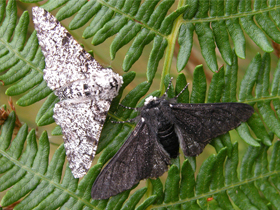In the 18th and 19th centuries, enormous changes took place in the industrial sphere first in Britain and then in other West European countries and America. Particularly in Great Britain, color changes were observed in some populations of animals due to the air pollution that increased with the Industrial Revolution. Industrial melanism is an expression of color changes allowed animals to camouflage themselves better.
Evolutionists attempt to account for these observed differences in color as natural selection under the pressure of environmental conditions. In fact, however, the situation stems from a complete misinterpretation of observed phenomena.
The most striking contemporary example of this directed selection is the evolution of protective colouring demonstrated by two Oxford University researchers called Ford and Kettlewell. They discovered that one kind of moth living in regions of Britain with a large number of factory chimneys were darker than moths living in other regions. It is known from collections that specimens previously collected (before industrialisation) were lighter in colour. Since the lighter-coloured moths lived on white and light coloured lichens found around tree trunks outside industrial regions, they adapted well to their environment and were able to avoid attracting the notice of predator birds. In industrial areas, since the soot from the chimneys darkened these lichens, white moths began to become more visible. In contrast, dark-coloured moths were better adapted. Since birds hunted the white moths, darker moths began to predominate and the genotype possessed by these began increasing in the population. White forms have today again begun to predominate in those regions of Britain in which air pollution has been eradicated.222
The point to be noted here is the presence of black moths caught prior to the beginning of the Industrial Revolution in Britain. In fact, this type of moth existed in Britain years before the Industrial Revolution. The change brought about by air pollution increased the likelihood of the white form, which had previously existed in large numbers, being seen by predators. As a result, there was a reduction in the numbers of this type and an increase in the numbers of darker moths. (See Peppered moths, the.)
It is clear that this change was in the numbers of the moths, not in their colors. This event can never be put forward as evidence of evolution. Proponents of the original creation of species accept this. In addition, even if there were a change in color as a result of mutation, this would still constitute no evidence for evolution, because the species of moth would still be the same species and would not have turned into any other. Evolution needs to scientifically prove that one species can evolve into another
What is happening here is not evolution, but only normal variation. Natural selection is only a mechanism that prevents members of a given species from disappearing as a result of environmental changes. (See Variation.)
The phenomena of variation and natural selection do not account for evolution in the way that by Darwin imagined. On the contrary, they’re excellent examples of a method of protection foreseen by creation. To put it another way, God has created all kinds of living things with systems to ensure their survival. An organism’s genetic system may be able to regulate its characteristics within certain bounds, according to changes in the surroundings. Otherwise, even minor changes in climate or food sources would spell the species’ death.
Many living things such as mammoths, dinosaurs, and flying reptiles have become extinct due to sudden environmental or climatic changes). These life forms disappeared when they were unable to adapt to environmental conditions exceeding the limits of the genetic potential they possessed when they were created. However, there is no scientific evidence that these turned into other species.
222 Prof. Dr. Ali Demirsoy, Kalıtım ve Evrim, Ankara: Meteksan Yayınları, 1984, p. 644.


